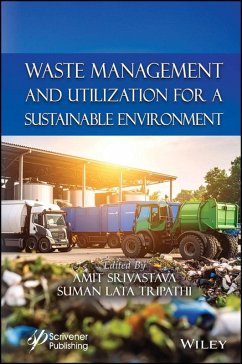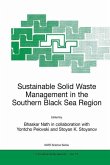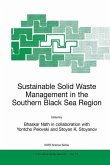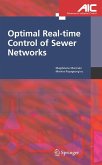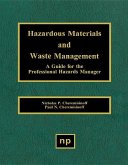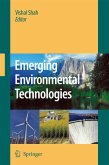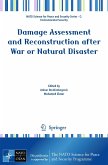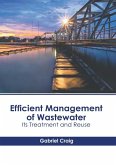Waste Management and Utilization for a Sustainable Environment
Herausgeber: Srivistava, Amit; Tripathi, Suman Lata
Waste Management and Utilization for a Sustainable Environment
Herausgeber: Srivistava, Amit; Tripathi, Suman Lata
- Gebundenes Buch
- Merkliste
- Auf die Merkliste
- Bewerten Bewerten
- Teilen
- Produkt teilen
- Produkterinnerung
- Produkterinnerung
Waste Management and Utilization for a Sustainable Environment is an essential guide to understanding how cutting-edge technologies and innovative engineering solutions can transform waste management into a cornerstone of a sustainable future. Civilized society produces enormous amounts of waste that must be managed to avoid negative impacts on the environment and ecosystem. Future generations depend on us for a sustainable future, bringing attention to this growing problem. Waste management and its utilization should be given paramount importance in technological development and innovation,…mehr
Andere Kunden interessierten sich auch für
![Sustainable Solid Waste Management in the Southern Black Sea Region Sustainable Solid Waste Management in the Southern Black Sea Region]() NathSustainable Solid Waste Management in the Southern Black Sea Region78,99 €
NathSustainable Solid Waste Management in the Southern Black Sea Region78,99 €![Sustainable Solid Waste Management in the Southern Black Sea Region Sustainable Solid Waste Management in the Southern Black Sea Region]() NathSustainable Solid Waste Management in the Southern Black Sea Region103,99 €
NathSustainable Solid Waste Management in the Southern Black Sea Region103,99 €![Optimal Real-Time Control of Sewer Networks Optimal Real-Time Control of Sewer Networks]() Magdalene MarinakiOptimal Real-Time Control of Sewer Networks103,99 €
Magdalene MarinakiOptimal Real-Time Control of Sewer Networks103,99 €![Hazardous Materials and Waste Management Hazardous Materials and Waste Management]() Nicholas P CheremisinoffHazardous Materials and Waste Management66,99 €
Nicholas P CheremisinoffHazardous Materials and Waste Management66,99 €![Emerging Environmental Technologies Emerging Environmental Technologies]() Emerging Environmental Technologies76,99 €
Emerging Environmental Technologies76,99 €![Damage Assessment and Reconstruction After War or Natural Disaster Damage Assessment and Reconstruction After War or Natural Disaster]() Adnan Ibrahimbegovic / Muhamed Zlatar (ed.)Damage Assessment and Reconstruction After War or Natural Disaster211,99 €
Adnan Ibrahimbegovic / Muhamed Zlatar (ed.)Damage Assessment and Reconstruction After War or Natural Disaster211,99 €![Efficient Management of Wastewater: Its Treatment and Reuse Efficient Management of Wastewater: Its Treatment and Reuse]() Efficient Management of Wastewater: Its Treatment and Reuse133,99 €
Efficient Management of Wastewater: Its Treatment and Reuse133,99 €-
-
-
Waste Management and Utilization for a Sustainable Environment is an essential guide to understanding how cutting-edge technologies and innovative engineering solutions can transform waste management into a cornerstone of a sustainable future. Civilized society produces enormous amounts of waste that must be managed to avoid negative impacts on the environment and ecosystem. Future generations depend on us for a sustainable future, bringing attention to this growing problem. Waste management and its utilization should be given paramount importance in technological development and innovation, where technology like AI, machine learning, computer vision, automation, and sensor technology has a vital role to play. Waste Management and Utilization for a Sustainable Environment provides a comprehensive overview of the latest research on innovative technologies shaping a more sustainable future. Through real-world case studies and expert insights, this book demonstrates that the future can be made sustainable through innovative engineering solutions for managing the enormous waste generated by society.
Produktdetails
- Produktdetails
- Verlag: Wiley
- Seitenzahl: 240
- Erscheinungstermin: 14. Oktober 2025
- Englisch
- ISBN-13: 9781394292974
- ISBN-10: 139429297X
- Artikelnr.: 75235871
- Herstellerkennzeichnung
- Libri GmbH
- Europaallee 1
- 36244 Bad Hersfeld
- gpsr@libri.de
- Verlag: Wiley
- Seitenzahl: 240
- Erscheinungstermin: 14. Oktober 2025
- Englisch
- ISBN-13: 9781394292974
- ISBN-10: 139429297X
- Artikelnr.: 75235871
- Herstellerkennzeichnung
- Libri GmbH
- Europaallee 1
- 36244 Bad Hersfeld
- gpsr@libri.de
Amit Srivastava, PhD is a professor in the Department of Civil Engineering at Graphic Era University with over 20 years of teaching, research, and industry experience. He has published one book and over 80 papers in international journals and conference proceedings. His research interests include geotechnical engineering, foundation analysis and design of super structures, and the stability of natural or manmade slopes, earth dams, and the design of retaining walls. Suman Lata Tripathi, PhD is a professor at Lovely Professional University with over 19 years of experience in academics. She has published over 74 research papers in refereed science journals and conferences, 15 books, 13 Indian patents, and two copyrights. Her area of expertise includes microelectronics device modeling and characterization, low-power VLSI circuit design, advanced FET design for IoT, and embedded system design.
Preface xi
Book Description xiii
1 Empowering E-Waste Management: A Framework for Collaboration among
Stakeholders in India 1
Balaji Ravi, Prabhakaran Duraisamy and Thirumarimurugan Marimuthu
1.1 Introduction 2
1.2 E-Waste Characteristics 4
1.3 Environmental Impact of E-Waste 5
1.4 Key Issues and Challenges of E-Waste Management in India 6
1.5 E-Waste Management Practices in India 6
1.5.1 Manual Separation of ICs from PWB 6
1.5.2 ICs Extraction from PWB 7
1.6 Literature Review 7
1.7 Public Awareness - A Study 8
1.7.1 Inference from Questionnaire-Based Survey 8
1.8 Case Study - E-Waste Handling 11
1.8.1 Information from Dismantler 11
1.8.1.1 Process in E-Waste Dismantling 11
1.8.1.2 Pre-Dismantling Process 11
1.8.1.3 Post-Dismantling Process 12
1.8.1.4 Recycling Processes at Recyclers 13
1.8.2 Information Collected from Dump Yard 14
1.8.2.1 Material Recovery Unit 14
1.8.3 Summary of E-Waste Generation at Dismantler and Dump Yard 16
1.9 Suggested Framework and Intervention 16
1.9.1 Framework Model for E-Waste Disposal 16
1.9.2 Implementation, Monitoring and Evaluation 17
1.10 Public Awareness, Education and Initiatives 17
1.11 Conclusions 18
References 18
2 Utilizing Granite Waste for Sustainable Construction: A Focus on AAC and
Concrete Blocks 23
Pravin Minde and Jagruti Patil
2.1 Introduction 24
2.1.1 Concept of Sustainability in Construction 25
2.1.2 Sustainable Materials in the Construction Industry 26
2.2 Various Types of Waste/Industry By-Products and Their Application in
the Construction Industry 27
2.3 Granite Waste and Its Characteristics 28
2.4 Various Applications of Granite Waste 29
2.5 AAC Blocks - Characteristics, Properties and Application 30
2.5.1 Advantages of AAC Blocks 31
2.6 Granite Waste in AAC Blocks 32
2.7 Experimental Analysis of Modified Granite Waste Blocks 34
2.7.1 Compressive Test and Result 34
2.7.2 Thermal Conductivity Test and Result 35
2.7.3 Water Absorption Test and Result 36
2.7.4 Acid Resistance Test and Result 37
2.8 Granite Waste in Concrete 38
2.8.1 Compressive Test and Result 44
2.8.2 Flexural Strength Test and Result 44
2.8.3 Split Tensile Strength Test and Result 45
2.9 Discussion and Future Scope 46
2.10 Conclusion 47
References 48
3 Valorization of Spent Foundry Sand into Building Products Using 2-Part
Epoxy-Bio Hardener 53
Deepasree Srinivasan, Arun Murugesan, Abdul Aleem Mohamed Ismail, Karthick
Jaisankar and Balaji Ravi
3.1 Introduction 54
3.2 Literature Section 54
3.2.1 Spent Foundry Sand 54
3.2.2 Polymeric Binder 55
3.3 Scope of Present Study 55
3.4 Materials: Spent Foundry Sand and Polymeric Binder 56
3.4.1 Origin of Spent Foundry Sand 56
3.4.2 Properties of Spent Foundry Sand 56
3.4.3 Environmental Concerns 57
3.4.4 Structure of Epoxy-Resin System 57
3.4.5 Properties of Polymeric Binder 58
3.5 Preparation of Polymer Composites 58
3.6 Techniques Followed 59
3.7 Building Products Using Spent Foundry Sand: A Study 59
3.8 Conclusion 64
Acknowledgment 64
References 65
4 Utilization of Various Industrial By-Products in Construction Industry as
Binder, Mortar and Concrete 69
Swaswati Roy and Kanmani S.
4.1 Introduction 70
4.2 Concrete as Construction Material 70
4.3 Cement as Binder 72
4.4 Current Scenario in Construction Industry 73
4.5 SCMs as Partial Replacement 74
4.6 Industrial By-Products as SCMs 75
4.7 Societal Impact Due to the Existing System 76
4.8 History of Existing Materials 77
4.9 Importance of Cementitious Material in Social Benefits 77
4.10 Industrial By-Products in Construction Industries and Their
Applications 78
4.11 Economic Benefits Due to the Usage of Industrial By-Products in
Construction 86
4.12 Discussion and Future Scope 86
4.13 Conclusion 87
References 88
5 Overcoming Challenges: E-Waste as a Filler Material in Concrete 95
Ganesh S. and Pushpendra Kumar Sharma
5.1 Introduction 96
5.2 Sources and Classification of E-Waste 97
5.3 Global Impact of E-Waste 98
5.4 E-Waste Management 99
5.5 Application of E-Waste in Construction 102
5.6 Conclusion 103
References 104
6 Transforming Waste Management: Sustainable Strategies for Environmental
Protection and Resource Recovery 109
Mamilla Vijaya Kumar and Hemadri Prasad Raju
6.1 Introduction 110
6.2 Solid Waste Management in India 110
6.2.1 MSW Framework 111
6.2.2 Sold Waste Generation 111
6.2.3 Composition of MSW 113
6.2.4 MSW Collection, Separation, and Transportation 114
6.2.5 Transfer Stations 117
6.2.6 Resource Recovery and Recycling 117
6.2.6.1 Mechanical Recycling 118
6.2.6.2 Thermal Treatment 118
6.2.6.3 Bioconversion Strategies 119
6.3 Waste Utilization for Sustainable Environment 120
6.3.1 MSW in Use in Construction 120
6.3.1.1 Geopolymer Cement 121
6.3.1.2 Plastics 121
6.3.1.3 Glass 121
6.3.1.4 Paper and Cardboard 122
6.4 Challenges and Issues in Sustainable Waste Management 122
6.4.1 Challenges in Solid Waste Management 122
6.4.1.1 Infrastructure and Resource Constraints 122
6.4.1.2 Institutional and Governance Issues 122
6.4.2 Environmental and Social Impacts 123
6.4.3 Disposal Sites and Emission of Landfill Gases 123
6.5 Problems Associated with Solid Waste Management 123
6.5.1 Waste Generation 123
6.5.2 Waste Collection 124
6.5.3 Waste Transport 124
6.5.4 Waste Treatment and Disposal 124
6.6 Conclusion 124
References 125
7 Handling E-Waste Complexities in Developing Countries: Awareness Level
and Legislative Behavior 133
Amandeep Kaur
7.1 Introduction 134
7.2 Literature Review 134
7.3 Objective of the Study 136
7.4 Awareness Level of People Regarding E-Waste and Its Safe Disposal 136
7.5 Challenges in E-Waste Management 137
7.6 Need for Stringent E-Waste Legislative Norms 138
7.7 Conclusion 139
References 140
8 Organic Field-Effect Transistor for Flexible and Eco-Friendly Degradable
Electronics 143
Buddari Venkatesh and Suman Lata Tripathi
8.1 Introduction 144
8.2 Charge Transport in Organic Semiconductors and OFETs 146
8.3 Architecture of OFETs 147
8.4 Types of OFET Architectures 149
8.5 Influence on Device Performance 149
8.6 Materials Used in OFET 150
8.6.1 Organic Semiconductors 150
8.6.2 Dielectric Materials 150
8.6.3 Electrodes 151
8.6.4 Gate Electrode 151
8.7 Organic Semiconductor Materials 152
8.8 Fabrication Process 155
8.8.1 Vacuum Evaporation 155
8.8.2 Liquid Deposition 155
8.8.3 Thin Film Alignment 156
8.9 Comparison with Conventional MOSFETs 158
8.10 Applications 158
8.11 Impact on Environment and Sustainability 159
8.12 Challenges and Future Scope 160
8.13 Conclusion 160
Acknowledgement 161
References 161
9 Artificial Intelligence for Environmental Monitoring, Conservation and
Waste Management 163
Sandhya Avasthi and Suman Lata Tripathi
9.1 Introduction 164
9.1.1 Artificial Intelligence Solutions for Environment Monitoring and
Conservation 164
9.1.2 Artificial Intelligence for Smart Waste Management 165
9.2 The Role of AI in Addressing Environmental Issues 166
9.2.1 Artificial Intelligence for Dealing with Climate Change 166
9.2.2 Using AI in Energy Conservation 167
9.2.3 AI in Environmental Monitoring 169
9.2.4 AI in Intelligent Transportation and Reducing Pollution 170
9.2.5 Potential of AI in Meeting SDGs 171
9.3 Smart Waste Management Solutions and Practices 172
9.3.1 A Generic Smart Waste Management Cycle 173
9.3.2 AI-Driven Waste Composition Analysis 173
9.3.3 Advanced Sensors and Machine Learning Algorithms 173
9.4 Machine Learning Algorithms in Identifying Patterns and Trends in
Environmental Data 174
9.5 AI-Powered Systems in Early Warnings for Natural Disasters Like
Hurricanes, Wildfires, and Tsunamis 178
9.6 AI Systems in Tracking and Protecting Endangered Species through Image
and Audio Recognition 179
9.7 Analyzing Water Quality, Soil Data, and Vegetation Changes by AI
Systems 181
9.8 Conclusions 184
References 185
10 A Critical Bibliometric Review of Plastic Waste Utilization in the
Construction Industry 189
Sourav Kumar Das, Nikhil Garg and Sandeep Shrivastava
10.1 Introduction 190
10.2 Article Selection Process 191
10.3 Method of Plastic Waste Utilisation 194
10.4 Application of Plastic Waste 195
10.4.1 Utilisation of Plastic Waste in Concrete 196
10.4.2 Drawbacks of the Utilisation of Plastic Waste in Concrete 200
10.4.3 Application of Plastic Waste in Other Building Materials 203
10.5 Limitations of the Utilisation of Plastic Waste 206
10.6 Conclusion 207
References 207
Index 211
Book Description xiii
1 Empowering E-Waste Management: A Framework for Collaboration among
Stakeholders in India 1
Balaji Ravi, Prabhakaran Duraisamy and Thirumarimurugan Marimuthu
1.1 Introduction 2
1.2 E-Waste Characteristics 4
1.3 Environmental Impact of E-Waste 5
1.4 Key Issues and Challenges of E-Waste Management in India 6
1.5 E-Waste Management Practices in India 6
1.5.1 Manual Separation of ICs from PWB 6
1.5.2 ICs Extraction from PWB 7
1.6 Literature Review 7
1.7 Public Awareness - A Study 8
1.7.1 Inference from Questionnaire-Based Survey 8
1.8 Case Study - E-Waste Handling 11
1.8.1 Information from Dismantler 11
1.8.1.1 Process in E-Waste Dismantling 11
1.8.1.2 Pre-Dismantling Process 11
1.8.1.3 Post-Dismantling Process 12
1.8.1.4 Recycling Processes at Recyclers 13
1.8.2 Information Collected from Dump Yard 14
1.8.2.1 Material Recovery Unit 14
1.8.3 Summary of E-Waste Generation at Dismantler and Dump Yard 16
1.9 Suggested Framework and Intervention 16
1.9.1 Framework Model for E-Waste Disposal 16
1.9.2 Implementation, Monitoring and Evaluation 17
1.10 Public Awareness, Education and Initiatives 17
1.11 Conclusions 18
References 18
2 Utilizing Granite Waste for Sustainable Construction: A Focus on AAC and
Concrete Blocks 23
Pravin Minde and Jagruti Patil
2.1 Introduction 24
2.1.1 Concept of Sustainability in Construction 25
2.1.2 Sustainable Materials in the Construction Industry 26
2.2 Various Types of Waste/Industry By-Products and Their Application in
the Construction Industry 27
2.3 Granite Waste and Its Characteristics 28
2.4 Various Applications of Granite Waste 29
2.5 AAC Blocks - Characteristics, Properties and Application 30
2.5.1 Advantages of AAC Blocks 31
2.6 Granite Waste in AAC Blocks 32
2.7 Experimental Analysis of Modified Granite Waste Blocks 34
2.7.1 Compressive Test and Result 34
2.7.2 Thermal Conductivity Test and Result 35
2.7.3 Water Absorption Test and Result 36
2.7.4 Acid Resistance Test and Result 37
2.8 Granite Waste in Concrete 38
2.8.1 Compressive Test and Result 44
2.8.2 Flexural Strength Test and Result 44
2.8.3 Split Tensile Strength Test and Result 45
2.9 Discussion and Future Scope 46
2.10 Conclusion 47
References 48
3 Valorization of Spent Foundry Sand into Building Products Using 2-Part
Epoxy-Bio Hardener 53
Deepasree Srinivasan, Arun Murugesan, Abdul Aleem Mohamed Ismail, Karthick
Jaisankar and Balaji Ravi
3.1 Introduction 54
3.2 Literature Section 54
3.2.1 Spent Foundry Sand 54
3.2.2 Polymeric Binder 55
3.3 Scope of Present Study 55
3.4 Materials: Spent Foundry Sand and Polymeric Binder 56
3.4.1 Origin of Spent Foundry Sand 56
3.4.2 Properties of Spent Foundry Sand 56
3.4.3 Environmental Concerns 57
3.4.4 Structure of Epoxy-Resin System 57
3.4.5 Properties of Polymeric Binder 58
3.5 Preparation of Polymer Composites 58
3.6 Techniques Followed 59
3.7 Building Products Using Spent Foundry Sand: A Study 59
3.8 Conclusion 64
Acknowledgment 64
References 65
4 Utilization of Various Industrial By-Products in Construction Industry as
Binder, Mortar and Concrete 69
Swaswati Roy and Kanmani S.
4.1 Introduction 70
4.2 Concrete as Construction Material 70
4.3 Cement as Binder 72
4.4 Current Scenario in Construction Industry 73
4.5 SCMs as Partial Replacement 74
4.6 Industrial By-Products as SCMs 75
4.7 Societal Impact Due to the Existing System 76
4.8 History of Existing Materials 77
4.9 Importance of Cementitious Material in Social Benefits 77
4.10 Industrial By-Products in Construction Industries and Their
Applications 78
4.11 Economic Benefits Due to the Usage of Industrial By-Products in
Construction 86
4.12 Discussion and Future Scope 86
4.13 Conclusion 87
References 88
5 Overcoming Challenges: E-Waste as a Filler Material in Concrete 95
Ganesh S. and Pushpendra Kumar Sharma
5.1 Introduction 96
5.2 Sources and Classification of E-Waste 97
5.3 Global Impact of E-Waste 98
5.4 E-Waste Management 99
5.5 Application of E-Waste in Construction 102
5.6 Conclusion 103
References 104
6 Transforming Waste Management: Sustainable Strategies for Environmental
Protection and Resource Recovery 109
Mamilla Vijaya Kumar and Hemadri Prasad Raju
6.1 Introduction 110
6.2 Solid Waste Management in India 110
6.2.1 MSW Framework 111
6.2.2 Sold Waste Generation 111
6.2.3 Composition of MSW 113
6.2.4 MSW Collection, Separation, and Transportation 114
6.2.5 Transfer Stations 117
6.2.6 Resource Recovery and Recycling 117
6.2.6.1 Mechanical Recycling 118
6.2.6.2 Thermal Treatment 118
6.2.6.3 Bioconversion Strategies 119
6.3 Waste Utilization for Sustainable Environment 120
6.3.1 MSW in Use in Construction 120
6.3.1.1 Geopolymer Cement 121
6.3.1.2 Plastics 121
6.3.1.3 Glass 121
6.3.1.4 Paper and Cardboard 122
6.4 Challenges and Issues in Sustainable Waste Management 122
6.4.1 Challenges in Solid Waste Management 122
6.4.1.1 Infrastructure and Resource Constraints 122
6.4.1.2 Institutional and Governance Issues 122
6.4.2 Environmental and Social Impacts 123
6.4.3 Disposal Sites and Emission of Landfill Gases 123
6.5 Problems Associated with Solid Waste Management 123
6.5.1 Waste Generation 123
6.5.2 Waste Collection 124
6.5.3 Waste Transport 124
6.5.4 Waste Treatment and Disposal 124
6.6 Conclusion 124
References 125
7 Handling E-Waste Complexities in Developing Countries: Awareness Level
and Legislative Behavior 133
Amandeep Kaur
7.1 Introduction 134
7.2 Literature Review 134
7.3 Objective of the Study 136
7.4 Awareness Level of People Regarding E-Waste and Its Safe Disposal 136
7.5 Challenges in E-Waste Management 137
7.6 Need for Stringent E-Waste Legislative Norms 138
7.7 Conclusion 139
References 140
8 Organic Field-Effect Transistor for Flexible and Eco-Friendly Degradable
Electronics 143
Buddari Venkatesh and Suman Lata Tripathi
8.1 Introduction 144
8.2 Charge Transport in Organic Semiconductors and OFETs 146
8.3 Architecture of OFETs 147
8.4 Types of OFET Architectures 149
8.5 Influence on Device Performance 149
8.6 Materials Used in OFET 150
8.6.1 Organic Semiconductors 150
8.6.2 Dielectric Materials 150
8.6.3 Electrodes 151
8.6.4 Gate Electrode 151
8.7 Organic Semiconductor Materials 152
8.8 Fabrication Process 155
8.8.1 Vacuum Evaporation 155
8.8.2 Liquid Deposition 155
8.8.3 Thin Film Alignment 156
8.9 Comparison with Conventional MOSFETs 158
8.10 Applications 158
8.11 Impact on Environment and Sustainability 159
8.12 Challenges and Future Scope 160
8.13 Conclusion 160
Acknowledgement 161
References 161
9 Artificial Intelligence for Environmental Monitoring, Conservation and
Waste Management 163
Sandhya Avasthi and Suman Lata Tripathi
9.1 Introduction 164
9.1.1 Artificial Intelligence Solutions for Environment Monitoring and
Conservation 164
9.1.2 Artificial Intelligence for Smart Waste Management 165
9.2 The Role of AI in Addressing Environmental Issues 166
9.2.1 Artificial Intelligence for Dealing with Climate Change 166
9.2.2 Using AI in Energy Conservation 167
9.2.3 AI in Environmental Monitoring 169
9.2.4 AI in Intelligent Transportation and Reducing Pollution 170
9.2.5 Potential of AI in Meeting SDGs 171
9.3 Smart Waste Management Solutions and Practices 172
9.3.1 A Generic Smart Waste Management Cycle 173
9.3.2 AI-Driven Waste Composition Analysis 173
9.3.3 Advanced Sensors and Machine Learning Algorithms 173
9.4 Machine Learning Algorithms in Identifying Patterns and Trends in
Environmental Data 174
9.5 AI-Powered Systems in Early Warnings for Natural Disasters Like
Hurricanes, Wildfires, and Tsunamis 178
9.6 AI Systems in Tracking and Protecting Endangered Species through Image
and Audio Recognition 179
9.7 Analyzing Water Quality, Soil Data, and Vegetation Changes by AI
Systems 181
9.8 Conclusions 184
References 185
10 A Critical Bibliometric Review of Plastic Waste Utilization in the
Construction Industry 189
Sourav Kumar Das, Nikhil Garg and Sandeep Shrivastava
10.1 Introduction 190
10.2 Article Selection Process 191
10.3 Method of Plastic Waste Utilisation 194
10.4 Application of Plastic Waste 195
10.4.1 Utilisation of Plastic Waste in Concrete 196
10.4.2 Drawbacks of the Utilisation of Plastic Waste in Concrete 200
10.4.3 Application of Plastic Waste in Other Building Materials 203
10.5 Limitations of the Utilisation of Plastic Waste 206
10.6 Conclusion 207
References 207
Index 211
Preface xi
Book Description xiii
1 Empowering E-Waste Management: A Framework for Collaboration among
Stakeholders in India 1
Balaji Ravi, Prabhakaran Duraisamy and Thirumarimurugan Marimuthu
1.1 Introduction 2
1.2 E-Waste Characteristics 4
1.3 Environmental Impact of E-Waste 5
1.4 Key Issues and Challenges of E-Waste Management in India 6
1.5 E-Waste Management Practices in India 6
1.5.1 Manual Separation of ICs from PWB 6
1.5.2 ICs Extraction from PWB 7
1.6 Literature Review 7
1.7 Public Awareness - A Study 8
1.7.1 Inference from Questionnaire-Based Survey 8
1.8 Case Study - E-Waste Handling 11
1.8.1 Information from Dismantler 11
1.8.1.1 Process in E-Waste Dismantling 11
1.8.1.2 Pre-Dismantling Process 11
1.8.1.3 Post-Dismantling Process 12
1.8.1.4 Recycling Processes at Recyclers 13
1.8.2 Information Collected from Dump Yard 14
1.8.2.1 Material Recovery Unit 14
1.8.3 Summary of E-Waste Generation at Dismantler and Dump Yard 16
1.9 Suggested Framework and Intervention 16
1.9.1 Framework Model for E-Waste Disposal 16
1.9.2 Implementation, Monitoring and Evaluation 17
1.10 Public Awareness, Education and Initiatives 17
1.11 Conclusions 18
References 18
2 Utilizing Granite Waste for Sustainable Construction: A Focus on AAC and
Concrete Blocks 23
Pravin Minde and Jagruti Patil
2.1 Introduction 24
2.1.1 Concept of Sustainability in Construction 25
2.1.2 Sustainable Materials in the Construction Industry 26
2.2 Various Types of Waste/Industry By-Products and Their Application in
the Construction Industry 27
2.3 Granite Waste and Its Characteristics 28
2.4 Various Applications of Granite Waste 29
2.5 AAC Blocks - Characteristics, Properties and Application 30
2.5.1 Advantages of AAC Blocks 31
2.6 Granite Waste in AAC Blocks 32
2.7 Experimental Analysis of Modified Granite Waste Blocks 34
2.7.1 Compressive Test and Result 34
2.7.2 Thermal Conductivity Test and Result 35
2.7.3 Water Absorption Test and Result 36
2.7.4 Acid Resistance Test and Result 37
2.8 Granite Waste in Concrete 38
2.8.1 Compressive Test and Result 44
2.8.2 Flexural Strength Test and Result 44
2.8.3 Split Tensile Strength Test and Result 45
2.9 Discussion and Future Scope 46
2.10 Conclusion 47
References 48
3 Valorization of Spent Foundry Sand into Building Products Using 2-Part
Epoxy-Bio Hardener 53
Deepasree Srinivasan, Arun Murugesan, Abdul Aleem Mohamed Ismail, Karthick
Jaisankar and Balaji Ravi
3.1 Introduction 54
3.2 Literature Section 54
3.2.1 Spent Foundry Sand 54
3.2.2 Polymeric Binder 55
3.3 Scope of Present Study 55
3.4 Materials: Spent Foundry Sand and Polymeric Binder 56
3.4.1 Origin of Spent Foundry Sand 56
3.4.2 Properties of Spent Foundry Sand 56
3.4.3 Environmental Concerns 57
3.4.4 Structure of Epoxy-Resin System 57
3.4.5 Properties of Polymeric Binder 58
3.5 Preparation of Polymer Composites 58
3.6 Techniques Followed 59
3.7 Building Products Using Spent Foundry Sand: A Study 59
3.8 Conclusion 64
Acknowledgment 64
References 65
4 Utilization of Various Industrial By-Products in Construction Industry as
Binder, Mortar and Concrete 69
Swaswati Roy and Kanmani S.
4.1 Introduction 70
4.2 Concrete as Construction Material 70
4.3 Cement as Binder 72
4.4 Current Scenario in Construction Industry 73
4.5 SCMs as Partial Replacement 74
4.6 Industrial By-Products as SCMs 75
4.7 Societal Impact Due to the Existing System 76
4.8 History of Existing Materials 77
4.9 Importance of Cementitious Material in Social Benefits 77
4.10 Industrial By-Products in Construction Industries and Their
Applications 78
4.11 Economic Benefits Due to the Usage of Industrial By-Products in
Construction 86
4.12 Discussion and Future Scope 86
4.13 Conclusion 87
References 88
5 Overcoming Challenges: E-Waste as a Filler Material in Concrete 95
Ganesh S. and Pushpendra Kumar Sharma
5.1 Introduction 96
5.2 Sources and Classification of E-Waste 97
5.3 Global Impact of E-Waste 98
5.4 E-Waste Management 99
5.5 Application of E-Waste in Construction 102
5.6 Conclusion 103
References 104
6 Transforming Waste Management: Sustainable Strategies for Environmental
Protection and Resource Recovery 109
Mamilla Vijaya Kumar and Hemadri Prasad Raju
6.1 Introduction 110
6.2 Solid Waste Management in India 110
6.2.1 MSW Framework 111
6.2.2 Sold Waste Generation 111
6.2.3 Composition of MSW 113
6.2.4 MSW Collection, Separation, and Transportation 114
6.2.5 Transfer Stations 117
6.2.6 Resource Recovery and Recycling 117
6.2.6.1 Mechanical Recycling 118
6.2.6.2 Thermal Treatment 118
6.2.6.3 Bioconversion Strategies 119
6.3 Waste Utilization for Sustainable Environment 120
6.3.1 MSW in Use in Construction 120
6.3.1.1 Geopolymer Cement 121
6.3.1.2 Plastics 121
6.3.1.3 Glass 121
6.3.1.4 Paper and Cardboard 122
6.4 Challenges and Issues in Sustainable Waste Management 122
6.4.1 Challenges in Solid Waste Management 122
6.4.1.1 Infrastructure and Resource Constraints 122
6.4.1.2 Institutional and Governance Issues 122
6.4.2 Environmental and Social Impacts 123
6.4.3 Disposal Sites and Emission of Landfill Gases 123
6.5 Problems Associated with Solid Waste Management 123
6.5.1 Waste Generation 123
6.5.2 Waste Collection 124
6.5.3 Waste Transport 124
6.5.4 Waste Treatment and Disposal 124
6.6 Conclusion 124
References 125
7 Handling E-Waste Complexities in Developing Countries: Awareness Level
and Legislative Behavior 133
Amandeep Kaur
7.1 Introduction 134
7.2 Literature Review 134
7.3 Objective of the Study 136
7.4 Awareness Level of People Regarding E-Waste and Its Safe Disposal 136
7.5 Challenges in E-Waste Management 137
7.6 Need for Stringent E-Waste Legislative Norms 138
7.7 Conclusion 139
References 140
8 Organic Field-Effect Transistor for Flexible and Eco-Friendly Degradable
Electronics 143
Buddari Venkatesh and Suman Lata Tripathi
8.1 Introduction 144
8.2 Charge Transport in Organic Semiconductors and OFETs 146
8.3 Architecture of OFETs 147
8.4 Types of OFET Architectures 149
8.5 Influence on Device Performance 149
8.6 Materials Used in OFET 150
8.6.1 Organic Semiconductors 150
8.6.2 Dielectric Materials 150
8.6.3 Electrodes 151
8.6.4 Gate Electrode 151
8.7 Organic Semiconductor Materials 152
8.8 Fabrication Process 155
8.8.1 Vacuum Evaporation 155
8.8.2 Liquid Deposition 155
8.8.3 Thin Film Alignment 156
8.9 Comparison with Conventional MOSFETs 158
8.10 Applications 158
8.11 Impact on Environment and Sustainability 159
8.12 Challenges and Future Scope 160
8.13 Conclusion 160
Acknowledgement 161
References 161
9 Artificial Intelligence for Environmental Monitoring, Conservation and
Waste Management 163
Sandhya Avasthi and Suman Lata Tripathi
9.1 Introduction 164
9.1.1 Artificial Intelligence Solutions for Environment Monitoring and
Conservation 164
9.1.2 Artificial Intelligence for Smart Waste Management 165
9.2 The Role of AI in Addressing Environmental Issues 166
9.2.1 Artificial Intelligence for Dealing with Climate Change 166
9.2.2 Using AI in Energy Conservation 167
9.2.3 AI in Environmental Monitoring 169
9.2.4 AI in Intelligent Transportation and Reducing Pollution 170
9.2.5 Potential of AI in Meeting SDGs 171
9.3 Smart Waste Management Solutions and Practices 172
9.3.1 A Generic Smart Waste Management Cycle 173
9.3.2 AI-Driven Waste Composition Analysis 173
9.3.3 Advanced Sensors and Machine Learning Algorithms 173
9.4 Machine Learning Algorithms in Identifying Patterns and Trends in
Environmental Data 174
9.5 AI-Powered Systems in Early Warnings for Natural Disasters Like
Hurricanes, Wildfires, and Tsunamis 178
9.6 AI Systems in Tracking and Protecting Endangered Species through Image
and Audio Recognition 179
9.7 Analyzing Water Quality, Soil Data, and Vegetation Changes by AI
Systems 181
9.8 Conclusions 184
References 185
10 A Critical Bibliometric Review of Plastic Waste Utilization in the
Construction Industry 189
Sourav Kumar Das, Nikhil Garg and Sandeep Shrivastava
10.1 Introduction 190
10.2 Article Selection Process 191
10.3 Method of Plastic Waste Utilisation 194
10.4 Application of Plastic Waste 195
10.4.1 Utilisation of Plastic Waste in Concrete 196
10.4.2 Drawbacks of the Utilisation of Plastic Waste in Concrete 200
10.4.3 Application of Plastic Waste in Other Building Materials 203
10.5 Limitations of the Utilisation of Plastic Waste 206
10.6 Conclusion 207
References 207
Index 211
Book Description xiii
1 Empowering E-Waste Management: A Framework for Collaboration among
Stakeholders in India 1
Balaji Ravi, Prabhakaran Duraisamy and Thirumarimurugan Marimuthu
1.1 Introduction 2
1.2 E-Waste Characteristics 4
1.3 Environmental Impact of E-Waste 5
1.4 Key Issues and Challenges of E-Waste Management in India 6
1.5 E-Waste Management Practices in India 6
1.5.1 Manual Separation of ICs from PWB 6
1.5.2 ICs Extraction from PWB 7
1.6 Literature Review 7
1.7 Public Awareness - A Study 8
1.7.1 Inference from Questionnaire-Based Survey 8
1.8 Case Study - E-Waste Handling 11
1.8.1 Information from Dismantler 11
1.8.1.1 Process in E-Waste Dismantling 11
1.8.1.2 Pre-Dismantling Process 11
1.8.1.3 Post-Dismantling Process 12
1.8.1.4 Recycling Processes at Recyclers 13
1.8.2 Information Collected from Dump Yard 14
1.8.2.1 Material Recovery Unit 14
1.8.3 Summary of E-Waste Generation at Dismantler and Dump Yard 16
1.9 Suggested Framework and Intervention 16
1.9.1 Framework Model for E-Waste Disposal 16
1.9.2 Implementation, Monitoring and Evaluation 17
1.10 Public Awareness, Education and Initiatives 17
1.11 Conclusions 18
References 18
2 Utilizing Granite Waste for Sustainable Construction: A Focus on AAC and
Concrete Blocks 23
Pravin Minde and Jagruti Patil
2.1 Introduction 24
2.1.1 Concept of Sustainability in Construction 25
2.1.2 Sustainable Materials in the Construction Industry 26
2.2 Various Types of Waste/Industry By-Products and Their Application in
the Construction Industry 27
2.3 Granite Waste and Its Characteristics 28
2.4 Various Applications of Granite Waste 29
2.5 AAC Blocks - Characteristics, Properties and Application 30
2.5.1 Advantages of AAC Blocks 31
2.6 Granite Waste in AAC Blocks 32
2.7 Experimental Analysis of Modified Granite Waste Blocks 34
2.7.1 Compressive Test and Result 34
2.7.2 Thermal Conductivity Test and Result 35
2.7.3 Water Absorption Test and Result 36
2.7.4 Acid Resistance Test and Result 37
2.8 Granite Waste in Concrete 38
2.8.1 Compressive Test and Result 44
2.8.2 Flexural Strength Test and Result 44
2.8.3 Split Tensile Strength Test and Result 45
2.9 Discussion and Future Scope 46
2.10 Conclusion 47
References 48
3 Valorization of Spent Foundry Sand into Building Products Using 2-Part
Epoxy-Bio Hardener 53
Deepasree Srinivasan, Arun Murugesan, Abdul Aleem Mohamed Ismail, Karthick
Jaisankar and Balaji Ravi
3.1 Introduction 54
3.2 Literature Section 54
3.2.1 Spent Foundry Sand 54
3.2.2 Polymeric Binder 55
3.3 Scope of Present Study 55
3.4 Materials: Spent Foundry Sand and Polymeric Binder 56
3.4.1 Origin of Spent Foundry Sand 56
3.4.2 Properties of Spent Foundry Sand 56
3.4.3 Environmental Concerns 57
3.4.4 Structure of Epoxy-Resin System 57
3.4.5 Properties of Polymeric Binder 58
3.5 Preparation of Polymer Composites 58
3.6 Techniques Followed 59
3.7 Building Products Using Spent Foundry Sand: A Study 59
3.8 Conclusion 64
Acknowledgment 64
References 65
4 Utilization of Various Industrial By-Products in Construction Industry as
Binder, Mortar and Concrete 69
Swaswati Roy and Kanmani S.
4.1 Introduction 70
4.2 Concrete as Construction Material 70
4.3 Cement as Binder 72
4.4 Current Scenario in Construction Industry 73
4.5 SCMs as Partial Replacement 74
4.6 Industrial By-Products as SCMs 75
4.7 Societal Impact Due to the Existing System 76
4.8 History of Existing Materials 77
4.9 Importance of Cementitious Material in Social Benefits 77
4.10 Industrial By-Products in Construction Industries and Their
Applications 78
4.11 Economic Benefits Due to the Usage of Industrial By-Products in
Construction 86
4.12 Discussion and Future Scope 86
4.13 Conclusion 87
References 88
5 Overcoming Challenges: E-Waste as a Filler Material in Concrete 95
Ganesh S. and Pushpendra Kumar Sharma
5.1 Introduction 96
5.2 Sources and Classification of E-Waste 97
5.3 Global Impact of E-Waste 98
5.4 E-Waste Management 99
5.5 Application of E-Waste in Construction 102
5.6 Conclusion 103
References 104
6 Transforming Waste Management: Sustainable Strategies for Environmental
Protection and Resource Recovery 109
Mamilla Vijaya Kumar and Hemadri Prasad Raju
6.1 Introduction 110
6.2 Solid Waste Management in India 110
6.2.1 MSW Framework 111
6.2.2 Sold Waste Generation 111
6.2.3 Composition of MSW 113
6.2.4 MSW Collection, Separation, and Transportation 114
6.2.5 Transfer Stations 117
6.2.6 Resource Recovery and Recycling 117
6.2.6.1 Mechanical Recycling 118
6.2.6.2 Thermal Treatment 118
6.2.6.3 Bioconversion Strategies 119
6.3 Waste Utilization for Sustainable Environment 120
6.3.1 MSW in Use in Construction 120
6.3.1.1 Geopolymer Cement 121
6.3.1.2 Plastics 121
6.3.1.3 Glass 121
6.3.1.4 Paper and Cardboard 122
6.4 Challenges and Issues in Sustainable Waste Management 122
6.4.1 Challenges in Solid Waste Management 122
6.4.1.1 Infrastructure and Resource Constraints 122
6.4.1.2 Institutional and Governance Issues 122
6.4.2 Environmental and Social Impacts 123
6.4.3 Disposal Sites and Emission of Landfill Gases 123
6.5 Problems Associated with Solid Waste Management 123
6.5.1 Waste Generation 123
6.5.2 Waste Collection 124
6.5.3 Waste Transport 124
6.5.4 Waste Treatment and Disposal 124
6.6 Conclusion 124
References 125
7 Handling E-Waste Complexities in Developing Countries: Awareness Level
and Legislative Behavior 133
Amandeep Kaur
7.1 Introduction 134
7.2 Literature Review 134
7.3 Objective of the Study 136
7.4 Awareness Level of People Regarding E-Waste and Its Safe Disposal 136
7.5 Challenges in E-Waste Management 137
7.6 Need for Stringent E-Waste Legislative Norms 138
7.7 Conclusion 139
References 140
8 Organic Field-Effect Transistor for Flexible and Eco-Friendly Degradable
Electronics 143
Buddari Venkatesh and Suman Lata Tripathi
8.1 Introduction 144
8.2 Charge Transport in Organic Semiconductors and OFETs 146
8.3 Architecture of OFETs 147
8.4 Types of OFET Architectures 149
8.5 Influence on Device Performance 149
8.6 Materials Used in OFET 150
8.6.1 Organic Semiconductors 150
8.6.2 Dielectric Materials 150
8.6.3 Electrodes 151
8.6.4 Gate Electrode 151
8.7 Organic Semiconductor Materials 152
8.8 Fabrication Process 155
8.8.1 Vacuum Evaporation 155
8.8.2 Liquid Deposition 155
8.8.3 Thin Film Alignment 156
8.9 Comparison with Conventional MOSFETs 158
8.10 Applications 158
8.11 Impact on Environment and Sustainability 159
8.12 Challenges and Future Scope 160
8.13 Conclusion 160
Acknowledgement 161
References 161
9 Artificial Intelligence for Environmental Monitoring, Conservation and
Waste Management 163
Sandhya Avasthi and Suman Lata Tripathi
9.1 Introduction 164
9.1.1 Artificial Intelligence Solutions for Environment Monitoring and
Conservation 164
9.1.2 Artificial Intelligence for Smart Waste Management 165
9.2 The Role of AI in Addressing Environmental Issues 166
9.2.1 Artificial Intelligence for Dealing with Climate Change 166
9.2.2 Using AI in Energy Conservation 167
9.2.3 AI in Environmental Monitoring 169
9.2.4 AI in Intelligent Transportation and Reducing Pollution 170
9.2.5 Potential of AI in Meeting SDGs 171
9.3 Smart Waste Management Solutions and Practices 172
9.3.1 A Generic Smart Waste Management Cycle 173
9.3.2 AI-Driven Waste Composition Analysis 173
9.3.3 Advanced Sensors and Machine Learning Algorithms 173
9.4 Machine Learning Algorithms in Identifying Patterns and Trends in
Environmental Data 174
9.5 AI-Powered Systems in Early Warnings for Natural Disasters Like
Hurricanes, Wildfires, and Tsunamis 178
9.6 AI Systems in Tracking and Protecting Endangered Species through Image
and Audio Recognition 179
9.7 Analyzing Water Quality, Soil Data, and Vegetation Changes by AI
Systems 181
9.8 Conclusions 184
References 185
10 A Critical Bibliometric Review of Plastic Waste Utilization in the
Construction Industry 189
Sourav Kumar Das, Nikhil Garg and Sandeep Shrivastava
10.1 Introduction 190
10.2 Article Selection Process 191
10.3 Method of Plastic Waste Utilisation 194
10.4 Application of Plastic Waste 195
10.4.1 Utilisation of Plastic Waste in Concrete 196
10.4.2 Drawbacks of the Utilisation of Plastic Waste in Concrete 200
10.4.3 Application of Plastic Waste in Other Building Materials 203
10.5 Limitations of the Utilisation of Plastic Waste 206
10.6 Conclusion 207
References 207
Index 211

